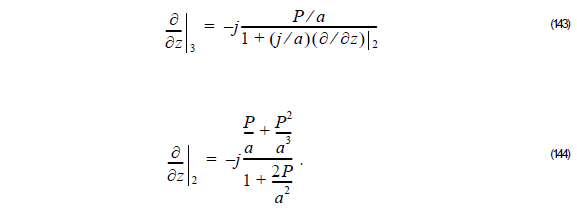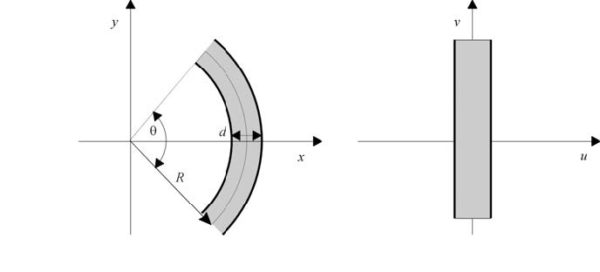Finite Difference Beam Propagation Method (FD-BPM) with Transparent Boundary Conditions

We can include the left-hand TBC expressing the field of the hypothetical node φ–1 (see Figure ) outside the analysis domain, (shown in “Transparent Boundary Condition” on page 23), as Here the parameter γL is determined by the known fields at z . Following similar way described we can include the right-hand TBC expressing the field φ…
Finite Element Beam Propagation Method (FE-BPM) with Perfectly Matched Layers

We proceed now with the solution of Equation 50 on the basis of the Finite Element Method [29] and [30]. As a first step we introduce the residual which must be zero in accordance with the state problem. However, it is impractical to enforce R( x ) = 0 at every point in the domain from…
Wide-Angle Beam Propagation Method based on Pade Approximant Operators

Here, we follow the Padé approximant approach to get the wide angle beam propagation [31]. It is worth it to point out that expansion via Padé is more accurate than Taylor expansion for the same order of terms. When Padé is employed, larger angles, higher index contrast and more complex mode interference can be analyzed in…
Fresnel Approximation (Pade 0th Order)

For paraxial approximant, we get the following equation: here a =2k0nre f , From Equation 119, we get and therefore where Thus, the unknown at field φ l + 1 at z + Δz is related to the known field φ l at z as follows: or Using Equation 127 we finally can get the unknown field φ…
Wide Angle (WA), Pade(1,1)

Using the recurrence formula Equation 118, we get: Here a = 2k0nref . Using Equation 119 into Equation 131, we get: Thus, and, where Thus, we can get the unknown field φ l + 1 at z + Δz from the known field φ l solving the triagonal linear system: If we consider FEM we get, Thus, we can…
Wide Angle (WA), Pade(2,2)

Using recurrence formula Equation 118 for Padé(2,2) we get: Here a = 2k0nref . Using Equation 144 into Equation 143, we get: From Equation 145, we get: Thus, and, where: Thus, the unknown field φ l + 1 at z + Δz is related to the known field φ l at z as follows: Multistep Method In order to…
Wide Angle (WA), Pade(3,3)

Using recurrence formula Equation 118 for Padé (3,3), we get: Using Equation 145 into Equation 169, we get: Finally, using Equation 171 into Equation 169, we get: Here a = 2k0nre f . From Equation 172, we get: Thus, and where Thus, the unknown field φ l + 1 at z + Δz is related to the known…
Wide Angle (WA), Pade(4,4)

Using recurrence formula Equation 118 for Padé (4,4) we get: Using Equation 191 into Equation 190 we get: From Equation 192, we get: Thus, and here Thus, the unknown field φ l + 1 at z + Δz is related to the unknown field φ l at z as follows: Multistep Method In order to solve Equation…
References
[1] M.D. Feit and J.A. Fleck, Jr.: Light Propagation in Graded-Index Optical Fibers, Appl. Opt. 17, (1978): 3990-3998. [2] M.D. Feit and J.A. Fleck, Jr.: Analysis of Rib Waveguides and Couplers by the Propagating Beam Method, J. Opt. Soc. Am. A 7, (1990): 73-79. [3] D. Yevick and B. Hermansson: Efficient Beam Propagation Techniques, IEEE J.…
Conformal Mapping Regions Introduction

Conformal mapping region in BPM is used to simulate curved optical waveguides. The method uses conformal mapping in the complex plane to transform a curved waveguide in ( x, y ) coordinates into a straight waveguide with a modified refractive index in new ( u, v ) coordinates (Figure 1). It can be used to treat…
Conformal Mapping Regions References
[1] M. Heiblum and J.H. Harris: Analysis of Curved Optical Waveguides by Conformal Mapping, IEEE J. Quant. Electron. 11, (1975): 75-83. [2] S.J. Garth: Modes on a Bent Optical Waveguide, IEEE Proc. J. 134, (1987): 221-229. [3] P.L. Fan, M.L. Wu, and C.T. Lee: Analysis of Abrupt Bent Waveguides by the Beam Propagation Method and the Conformal…
Titanium Diffusion in Lithium Niobate
The Titanium diffused waveguides in Lithium Niobate, or the Ti:LiNbO3 waveguides, are formed by the diffusion of the Titanium dopant into the Lithium Niobate host. To form a waveguide, a stripe of Titanium is deposited on the LiNbO3 substrate. For a given stripe width, which we identify with the waveguide width, the amount of Titanium…
Magnesium Diffusion in Lithium Niobate
The diffusion of Magnesium dopant into the Lithium Niobate host induces negative index changes. The process starts by deposition of a stripe Magnesium source, usually the oxide of Magnesium, onto the Lithium Niobate crystal. The sample is then heated for several hours, similar to the Titanium diffusion process. Formally, the resulting refractive index distribution can be…
Proton Exchange Process in Lithium Niobate

Proton exchange in Lithium Niobate involves a replacement of Lithium ions (Li+) by hydrogen ions, or protons (H+). The replacement causes a change in refractive index, thus forming a waveguide. Proton exchange is one of the methods used for forming optical waveguides in Lithium Niobate, LiNbO3, as well as in Lithium Tantalate, LiTaO3. The waveguide…
Introduction

The electrooptic effect is the modification of the refractive index by an externally applied electrostatic field. In the linear electrooptic effect, the size of the perturbation to the refractive index is directly proportional to the strength of the local electrostatic field. In OptiBPM, there are two features to model in the linear electrooptic effect; one is…

